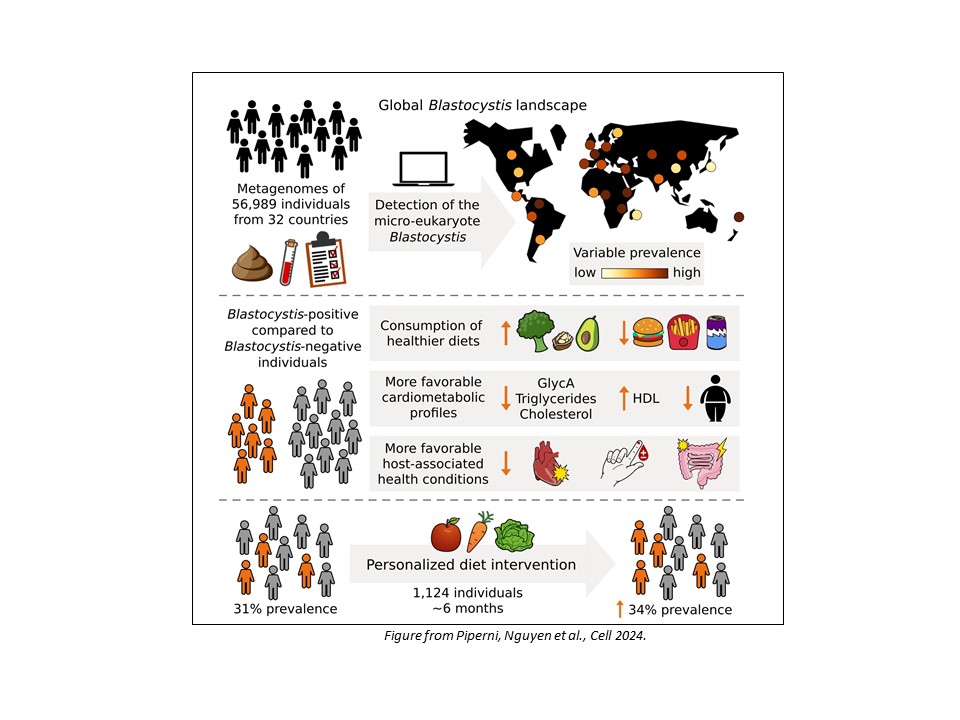
The human gut microbiome is an ensemble of living microorganisms colonizing the human intestine. Bacteria inhabiting the gut have been largely explored and several studies have highlighted their role in host health and disease. For instance, in cancer, intestinal bacteria are crucially involved in response to immunotherapy, and previous studies suggest that, in neuroblastoma, they may be exploited to ameliorate tumor-associated symptoms. However, the gut microbiome also contains eukaryotic microorganisms, which have been so far largely understudied.
Do they play a role in human health and pathology similar to what gut bacteria do?
In a recent study, coordinated by Nicola Segata -Group leader of the Department of Experimental Oncology of IEO and professor at the University of Trento- and Francesco Asnicar -of the University of Trento-, Elisa Piperni -PhD student in Segata’s group- and colleagues showed that Blastocystis, a specific eukaryotic gut microorganism, is a marker of -and possibly an active player in- human health. Specifically, the authors found that Blastocystis prevalence is related to the diet, is anticorrelated with body weight, increases after dietary intervention improving diet quality, and is positively correlated with cardiometabolic health, strongly suggesting a potentially active and beneficial role of Blastocystis in human health.
A healthy lifestyle, including a healthy dietary regimen, with high consumption of plant-based food and low consumption of processed food, is commonly advised to reduce the risk of chronic diseases, and the gut microbiota represents a link and underlying mechanistic reason for this recommendation. This study indicates a pivotal role of Blastocystis in this scenario, especially in the context of cardiometabolic health.
Is it plausible to hypothesize a similar role of Blastocystis in cancer? “In this work -explains Elisa Piperni, first author of the paper- we show that Blastocystis is enriched in healthy individuals in several case-control studies, mostly focusing on diabetes, inflammatory bowel disease, and colorectal cancer, suggesting a favorable role of Blastocystis in human health which should be clarified with further experimental works. Moreover, Blastocystis presence in the gut is currently an exclusion criterion for potential donors of fecal microbiota transplantation (FMT) interventions. Our results highlight that novel studies are needed to evaluate the safety and efficacy of FMT also from Blastocystis-positive donors. Certainly, our work highlights the importance of exploring the non-bacterial component of the gut microbiota.”
---
By analyzing ⁓57k metagenomic samples with computational approaches, the authors investigated Blastocystis presence in the human microbiome. They showed that Blastocystis was present only in the gut (and neither in the oral cavity nor on the skin) and its prevalence varied geographically (e.g. ⁓7% in North America vs ⁓22% in Europe), and with body weight (being less prevalent in overweight/obese individuals). In addition, Blastocystis was not present in newborns, indicating that it was not vertically transmitted from mother to infant. Blastocystis was also detected in ancient samples (for example in paleofeces that date back to 595 AD), indicating that its prevalence is not strictly linked to modern lifestyles. Moreover, Blastocystis colonization persisted over time; and analyses on twins showed it to be unrelated to the host genetics and rather linked to environmental factors.
Blastocystis presence was also associated with the diet type (that is, omnivore, vegetarian, and vegan), showing to be more prevalent in vegetarians. Interestingly, even among individuals with comparable diet quality, Blastocystis presence was associated with lower body mass index, suggesting a direct effect of Blastocystis on adiposity.
Deepening the analysis and focusing on the prevalence of each specific human subtype of Blastocystis in relation to geographic location and lifestyle (namely westernized vs. non-westernized lifestyle, which considers factors such as diet, calorie and fat intake, use of antibiotics or pharmaceuticals, etc.), the authors observed that prevalence of the different subtypes (STs) varied according to lifestyle: for instance, ST1 and ST2 were more prevalent in non-westernized populations, while ST4 was detected only in westernized populations, and was common in Europeans. Moreover, the Blastocystis subtypes profiled were poorly present in non-human hosts (and when it did happen, it was mostly primates held in captivity).
Markers of cardiometabolic health were associated with Blastocystis presence (but not specifically associated with the different Blastocystis subtypes). Notably, Blastocystis was per se a marker of cardiometabolic health, independently from the diet, suggesting that Blastocystis presence may have a beneficial effect on cardiometabolic health, in addition to diet. Overall, Blastocystis was more prevalent in healthy individuals compared to diseased subjects, suggesting that it may be a member of a healthier gut microbiome.
As Blastocystis inhabits the human gut together with bacteria, the authors evaluated the interaction between Blastocystis and other microbiota members. The results showed that Blastocystis-positive individuals had higher alpha diversity (namely, number of species) and a specific bacterial composition, which could be exploited to predict Blastocystis presence. They also identified several bacterial species strongly correlated and anticorrelated with Blastocystis presence, suggesting a link between the bacterial fraction of the gut microbiome and Blastocystis.
Finally, in a 6-month personalized diet-intervention on more than one thousand individuals, the authors showed that Blastocystis prevalence and abundance increased after improving diet quality. In particular, Blastocystis was acquired in about twice the number individuals in which instead it was lost, and its relative abundance increased in individuals that were Blastocystis-positive both before and after the intervention, suggesting a positive impact of diet improvement on Blastocystis presence. An in-depth look at the dietary regimen revealed that Blastocystis increase was linked to higher fiber intake and decreases in body weight.